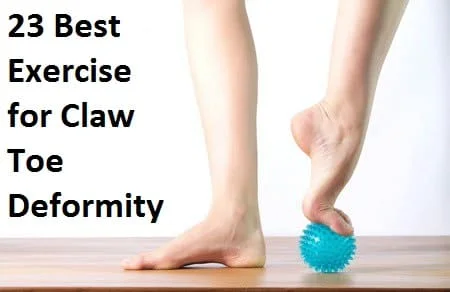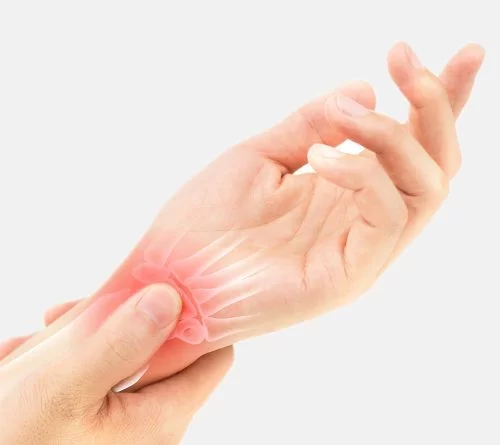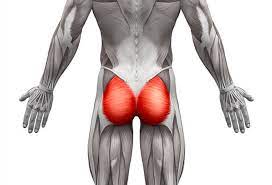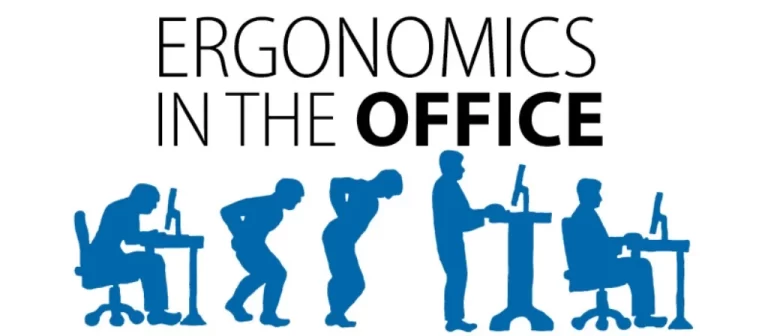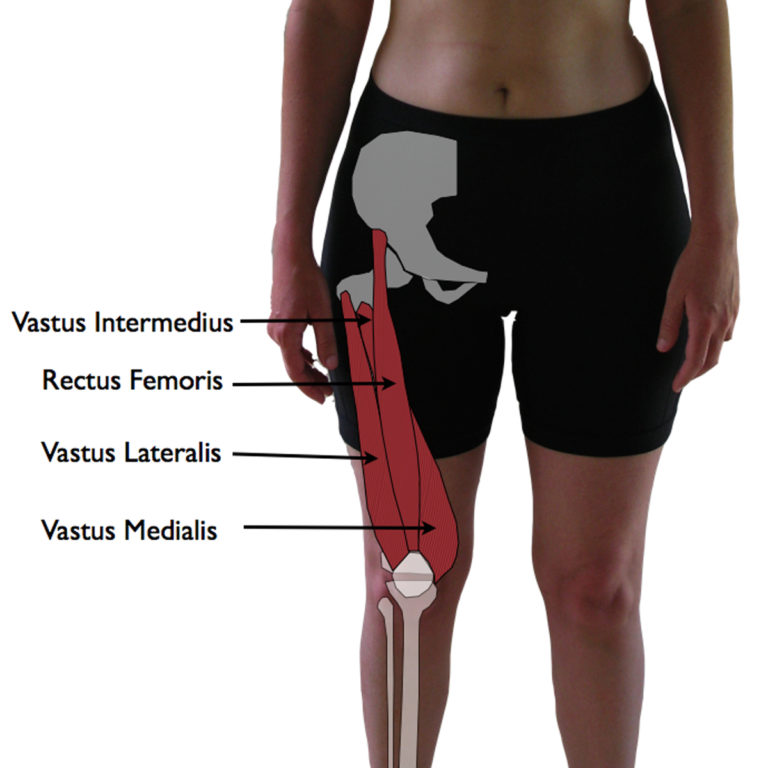23 Best Exercise for Claw Toe Deformity
Table of Contents
Introduction
Exercise for Claw Toe Deformity is an important part of your overall treatment program along with Medical treatment, Corrective Splint.
The Claw Toe Deformity is progressive and joints tend to become stiffer and more painful over time – but regular exercise will help keep muscles and tendons light, flexible, and pain-free for as long as possible. Toe stretches not only feel good, but they can also help you treat foot problems and prevent them in the future. They can help prevent problems. In this article, you can learn stretching exercises, mobility exercises,s and strengthening exercises of the foot which provide mobility and flexibility to the muscles.
Claw toes, as the name suggests, are toes that are bent into an abnormal claw-like shape. The condition usually occurs in the four smaller toes of your foot, and the metatarsal and metatarsal joints (the joints farthest from the ankles) buckle. Club toes are often associated with a high arch (cavus) type of foot, muscle imbalances, or sometimes a neurological condition.
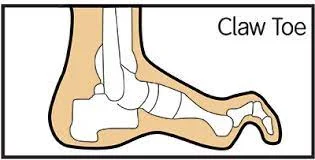
Diabetics can develop ulcers due to decreased sensitivity in their feet. Ingrown toenails are often the result of nerve damage caused by diseases such as diabetes or alcoholism, which can weaken the muscles in the feet. Nails can get worse without treatment and become permanent deformities over time. If you don’t treat your toenails, they can become permanently hard.
A bunion means that the toes “claw,” digging into the soles of the shoes and causing painful calluses. A bunion can occur at any age, but it mostly affects people between the ages of 60 and 80. It is mostly seen in women compared to the male.
Types of Claw Toes
Flexible Claw Toes: This type of claw toe is caused by the weakening of the leg muscles over time or as a result of trauma. As a result, the toes curl down and get stuck in that position. People with this condition may experience pain when wearing certain types of shoes, have difficulty walking, and may have difficulty bending or extending their toes properly.
Rigid Claw Toes: Stiff claw toes are much more difficult compared to flexible toes because the joints of the toe become stiff and cannot be properly bent or stretched. It is usually caused by an injury to the leg, such as a fracture or trauma, which can damage the nerves and muscles in the affected joint area. People with this condition often experience extreme discomfort when walking and difficulty choosing shoes and activities that require long periods of standing or walking.
Congenital Claw Toes: Congenital clubfoot is a condition that occurs at birth before the affected area of the foot is injured. In some cases, congenital sinusitis can be corrected over time with special exercises, while other times it may require surgery if it causes significant enough damage or causes excess discomfort or pain such as activity which is walking and while wearing shoes.
Causes of Claw Toe Deformity
Poorly-fitted shoes which cause your toes to extend (e.g. high-heeled shoes with pointed shoes)
Tight or restrictive footwear
Nerve damage caused by diabetes.
Rheumatoid arthritis or osteoarthritis.
Nerve damage cause by alcoholism.
Charcot-Marie-Tooth Disease.
Spinal cord tumors.
Polio and cerebral palsy.
Stroke. The stroke-side foot is affected.
Genetics
Trauma or accident
Bunions
Symptoms of Claw Toe Deformity
Claw toes are more than just bent toes. Additional symptoms include:
Corns or calluses. (Thickening of skin over affected area)
Walking and balance difficulties due to the incorrect position of the toes
Pain in the foot and/or toes when wearing shoes
The toes are bent upwards at the ball joints (extension).
The toes are bent down (flexion) from the middle joint to the bottom of the shoe.
Sometimes the toes also bend from top to bottom and curve under the sole.
Weakening of the forefoot muscles
Blisters.
Swelling.
Ulcers (rare).
Best Exercise for Claw Toe Deformity
Big toe stretch
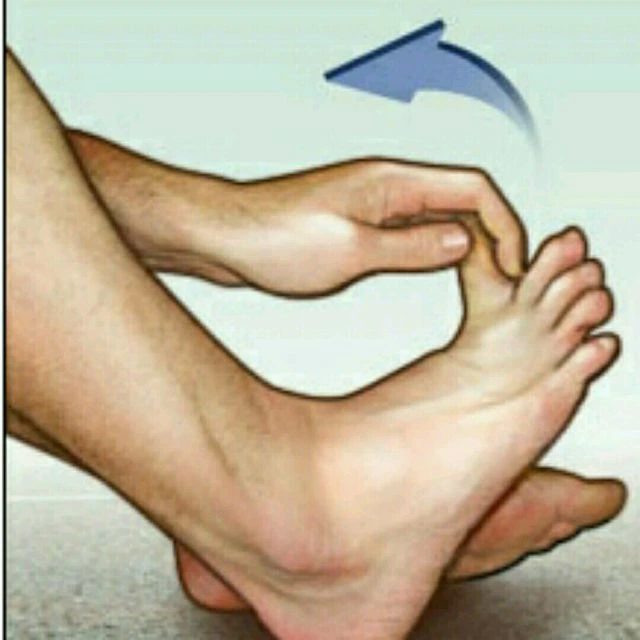
This stretch is good if your toes have been compressed from such activity by wearing tight or pointy shoes.
start with the Sitting position with keep your feet flat on the ground.
Then you should raise your right hip and keep your ankle on the left side of the knee.
Using your hands, give movement your toe flexion and toe extension, and performed to each side, holding the flexion position for five seconds and also holding the extension position for five seconds.
Repetition should be 15-20 times per session and three sets per day.
change the toe and repeat the stretch on the other big toe of your foot.
Finger toe stretch
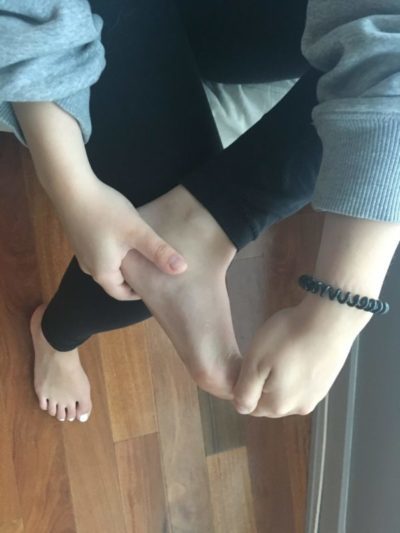
This stretch provides the release pressure on the posture of the claw toe and painful toes.
Start with the Sitting position with keep your feet flat on the ground. the benefit of this stretch is that It improves posture. It improves the flexibility of muscles(extensor digitorum brevis and extensor hallucis brevis). then Lift your right leg and place your ankle on your left thigh.
Intertwine the fingers of your right hand with your toes.
Stretch your toes apart with your fingers as long as you are able. then keep your foot back on the ground.
Repetition should be 15-20 times per session and three sets per day. change the toe and repeat on the big toe of your left foot.
Toe extension
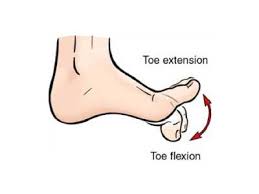
You should feel this stretch under your foot. Massage the arch of your foot with your thumbs before exercise and then do this stretch to increase the effect of the exercise. This stretch is great to prevent or manged claw toe deformity which is the reason for heel pain.
Start with the Sitting position with keep your feet flat on the ground.
Raise the leg with the claw toe and place that ankle on the opposite leg.
Flex your toes up toward your shin. hold the toe extension position for around five to ten seconds which is necessary. Repetition should be 15-20 times per session and three sets per day. change the toe and repeat the stretch on the other big toe of your foot.
Toe lift
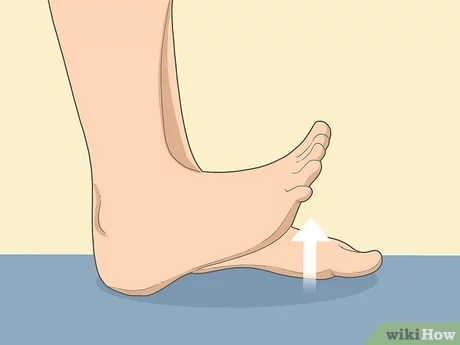
The toe lift exercise is a great exercise to help you increase the strength, mobility, and stability of the toe muscles which are situated on the front of your ankle and lower extremity. the name of muscles — especially the tibialis anterior, which is a muscle anterior aspect of the shin — enables you to lift your toes and foot upward (an ability called ankle dorsiflexion). Adding toe raises in your daily routine life it can help maintain ankle mobility.
you can perform this stretch only for one foot at a duration or with both feet together.
Sit on the unsupported chair with your feet flat on the ground.
gradually Lift your toes, trying to raise them all to the same level.
Hold the raised position around for five seconds. then back to the normal position.
Repetition should be 15-20 times per session and three sets per day. change the toe and repeat the stretch on the other big toe of your foot.
Modification or progression of the toe raise exercise
Standing toe raises (only one or both feet) with the support of any object
Standing toe raises one foot at a time without the support of any object
Standing toe raises one foot at a time, with proper hold onto a wall or chair.
Seated toe raises with both feet on the ground
Seated toe raises, with alternating foot
Toe lift and press
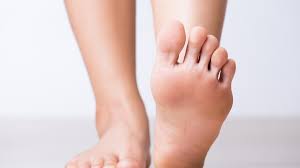
This toe lif and press exercise improves your ankle control over toe movements as well as provides strength to the foot muscles.
start the exercise with a Sitting position with your feet flat on the ground.
Then you can Lift your toes on one foot or both feet at the same duration, trying to lift them all to the same level which is necessary. then press only your big toe down and do it 10-15 times.
Press only your little toe up and down do it 10-15 times.
you should one by one provide pressure to your big toe up and down one time by pressing your little toe up and down one time. Repetition should be 15-20 times per session and three sets per day. change the toe and repeat the stretch on the other big toe of your foot.
Lateral toe stretch
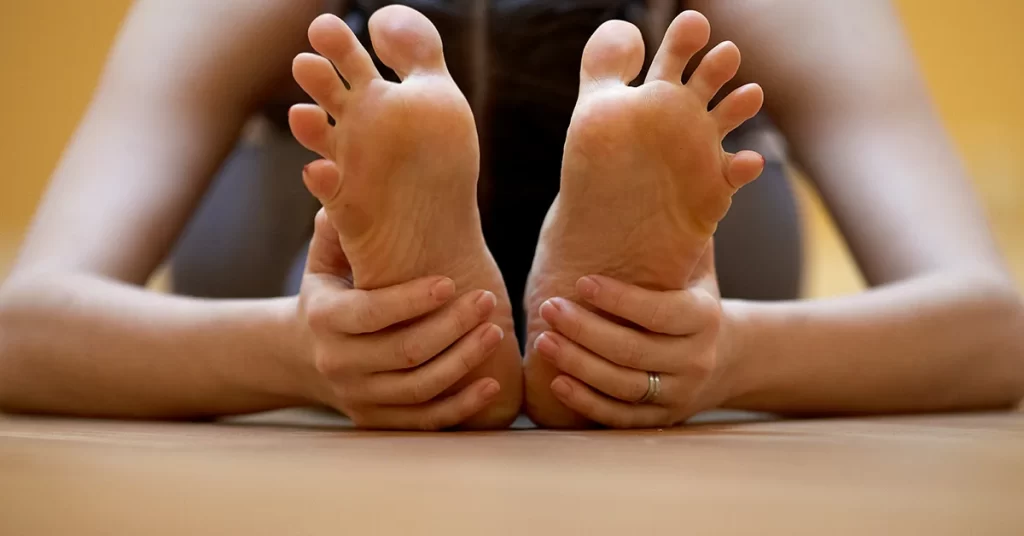
The lateral toe stretch will stretch your toes from the lateral aspect(side) instead of the anterior aspect. You can stretch it one leg at a time or both legs together. Sit with your feet on the floor. Point your toes up. Move your toes to the lateral aspect without moving your foot. Hold for 5 seconds. Relax your toes. Point your toes up. Move your toes to the opposite side without moving your foot. Hold for 5 seconds. Relax your toes. Repeat the stretch with your toes down. Repetitions should be 15-20 times per session, do three sets a day.
Toe Curls
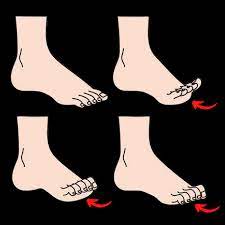
The benefit of the towel curl exercise is that it improves the balance of the foot, supports the arch, and increases the overall muscle strength of the foot. The curl can also improve strength, which helps with balance. Physiotherapists often recommend this exercise to people with plantar fasciitis because increasing the flexibility of the foot helps with heel pain and stiffness. Flatten a sheet or tape and place one foot flat on it. You move the towel towards you, so keep the extra fabric in front of your leg. (If you’re using a strap, extend it long enough in front of you to give your toes something to grab onto.)
Sit in a chair (standing works too), heels under your knees. Keeping the heel under, lift the toes and bend the leg back. Leave your heel on the towel as you extend your leg equally to both sides and center so that your foot lands on the towel as far as possible. Keep your heel still and pull the towel toward you, pulling it up with your arch and toes.
Use both sides of your foot (all five toes) and try to create a deep arch under the arch. You only move a small part of the towel each time you stretch and pull back. You may need to take a break after a few repetitions to smooth out the cloth or band. Repeat the movement at least five times and then do it on the other leg. You can do this exercise every day or even several times a day.
Modifications and Variations
Include the weight: Once you have very good toe curls, you can add the progression challenge to the exercise by including a small weighted object to the far end of the napkin.
Start with a lighter weight like 4-6 oz. You can use any cosmetics you have. Add weight by trying a small can of soup. Once you know the weight, choose a larger jar.
Towel Push: Push the towel loop forward in a reverse motion, curling and opening the toes. Again, keep your heel on the floor so your ankle or heel is not doing any work.
Toe raise, point, and curl
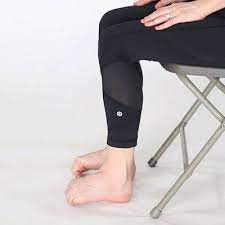
This exercise has three phases and helps to strengthen all parts of the legs and toes. How to do this exercise: Sit straight in a chair with your feet on the floor. Keep your toes on the floor and lift your heels. Toe curls are a great exercise to strengthen your legs. This exercise can stretch the foot muscles and improve your balance of foot, support the arch, and increase overall foot muscle strength. Toe curls can also help reduce or prevent pain in foot injuries such as plantar fasciitis.
This exercise is divided into the three-part it will start to get your toes and feet moving.
Sit without a supported or straight-backed chair with your feet flat on the ground.
Hold for five seconds. Point your toes so that only the tips of the big toe and second toe touch the ground. Hold for five seconds. Keep your heels off the ground and curl your toes down so that the tops of your toes touch the ground. Hold for five seconds. change the toe and repeat the stretch on the other big toe of your foot. Repetition should be 15-20 times per session and three sets per day.
Toe splay
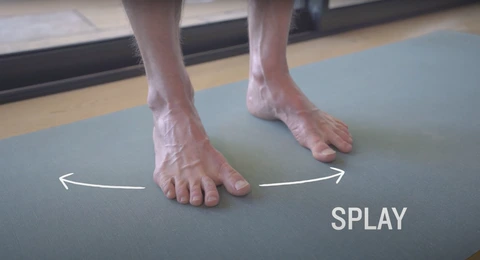
The benefit of toe splay exercise is Improves blood flow, Addresses ankle, foot, and toe pain, Strengthens your feet, Helps restore proper bone orientation, and Promotes better balance and weight distribution. Toe splay exercises provide strength to the intrinsic foot muscles, and improve balance, flexibility, and stability.
the toe splay movement will help you regain control over your toe muscles.
start with a sitting position in a straight-backed chair with your feet gently resting on the ground.
Spread all your toes as you can. Hold the spread to around five to ten seconds.
We recommend using toe separators, toe separators, or toe tape for at least 10 minutes a day in the beginning. From there you can continue your journey up. Start slowly and rest your legs if you start to feel pain. Repetition should be 15-20 times per session and three sets per day. Change the toe and repeat the stretch on the other big toe of your foot. You can make the modification of the exercise by looping a resistance band around the toes of each foot.
Figure eight rotation
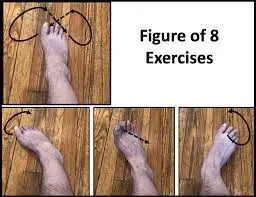
The figure eight rotation exercise is similar to the toe movement exercise, in this exercise, you make the figure of eight use of the big toe (you move your toes in a figure eight movement instead of a circular motion). the major benefit of this exercise is the improved mobility of the toes and fingers of the foot.
Repeat 10 times for each toe, 2-3 sets. The Figure eight rotation is a very simple and easy exercise.
Toe circles
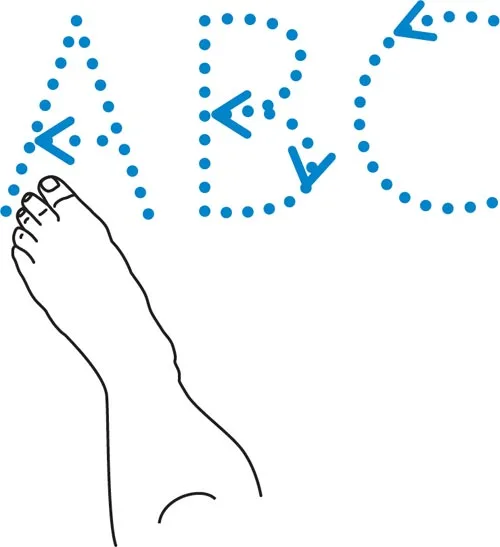
The benefit of this exercise is that it is designed to stretch and strengthen your feet and ankles using a range of motion. Read all instructions before starting your workout. Breathe normally while exercising. If you experience any discomfort during exercise, then you can stop the exercise.
For the toe circle exercises, you can sit in a chair. Bring your ankle to the knee and keep it on the ankle then with a hand roll of the big toe(in the circular movement) you can do this actively or passively. It continues to travel together. at the starting phase of the exercise, these physical activities may also experience unnatural and difficult to do, but with time and with consistency, you will get the proper circular motion of the big toe. you can perform the toe circles exercise for three to five minutes. performed three sets per day.
Doming
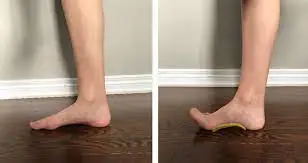
A foot doming exercise leg is a good way to target these anterior aspects of foot muscles. You can do this by trying to pull the big toe towards the heel while creating a “dome” under the foot as shown above. The challenge is to try to hold the dome while placing your toes on the floor. This is more or less the same as the test described above. Do not move your toes and try to keep your ankles and feet in a neutral position. This exercise can be done in different positions such as sitting, standing, standing on one leg, and then moving to other movements (quads and pull-ups) depending on how ambitious you are. This stretch strengthens your toes and lifts (“dome”) your arches. Sit with your feet on the floor. Try to hold the floor with your toes. Make sure you are using a gripping motion, not just curling your toes. Hold the dome pose for about five to ten seconds. Repetitions should be 15-20 times per session, do three sets a day
During progression duration adding Heavy Resistance Training
Progression practitioners commonly give patients gradually, controlled but relatively minimum weight. patients get many benefits from performing this resistance band training because this training provides strength to the foot muscles. this progression exercise is another way to increase the capacity of your foot muscles.
Strengthen the muscles with toe pulls
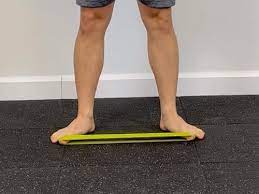
This exercise is also known as toe pulls, this exercise can improve strength and flexibility. It stretches the muscles and tendons of the leg, reducing stiffness and increasing mobility of the affected joint. mostly, this exercise can improve the stability of your foot muscles and prevent further injury to the foot. Place a towel or small towel under your feet while you sit with your feet flat on the floor.
Pull the resistance band towards you with your toes and flexion of your toes in the same way. Hold the flexion position of the toes for around five to ten seconds, then release and repeat then the exercise. during the progression period, you can some objects for strengthening of foot muscles.
Repetitions should be 15-20 times per session, do three sets a day
Toe resistance exercises
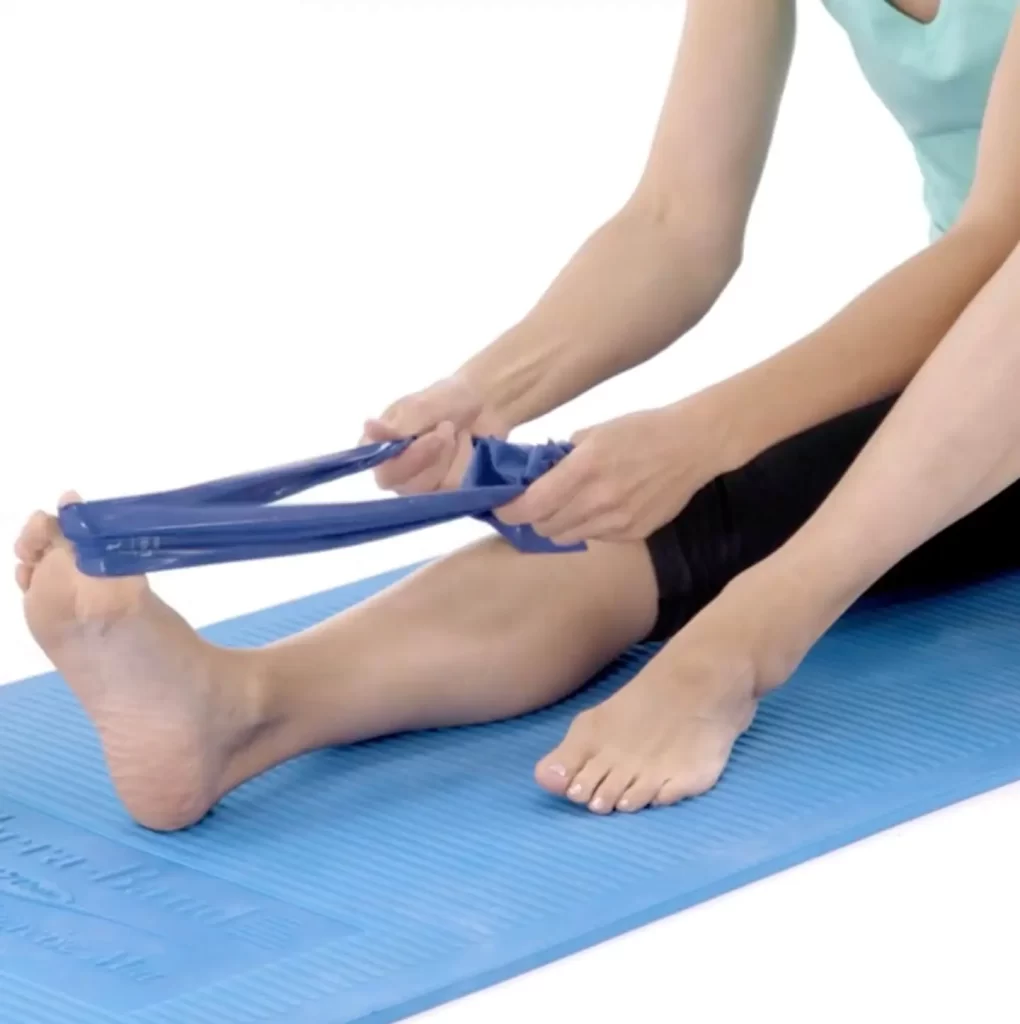
For the resistance exercise, take a long sitting position on a mat or plinth and you have a resistance band(theraband) for this exercise. Start with your hands or different big toes to create resistance so that the small muscle groups in the foot are remotely controlled and activated. wrap the resistance band around the toe and do flexion movement of the toes. Hold the movement in the opposite direction for five to ten seconds.
Then place your fingers under the toe and practice effort by pushing the toes up. At the same time, press your toe down and hold the position for around five to ten seconds. Finally, move your finger in the opposite direction of the resistance band, (pushing it towards the finger). As you apply this tension, move the big toe away from the fingers of the foot. Do this entire exercise five to ten on each foot. three series were presented per day.
Repetitions should be three to five times per session, do three sets a day.
Toe Yoga

The benefit of yoga it provides strength to the muscles which weaken by this toe deformity. Improving toe dexterity helps develop the strength needed to stabilize the front of the foot against the ground. Lift the big toe by pressing the other 4 toes. Hold for 5 seconds. Press the big toe into the ground and lift the other 4 toes. Hold for 5 seconds. you should repeat this exercise 15-20 times per session, three to five times per day.
Toe Crawling
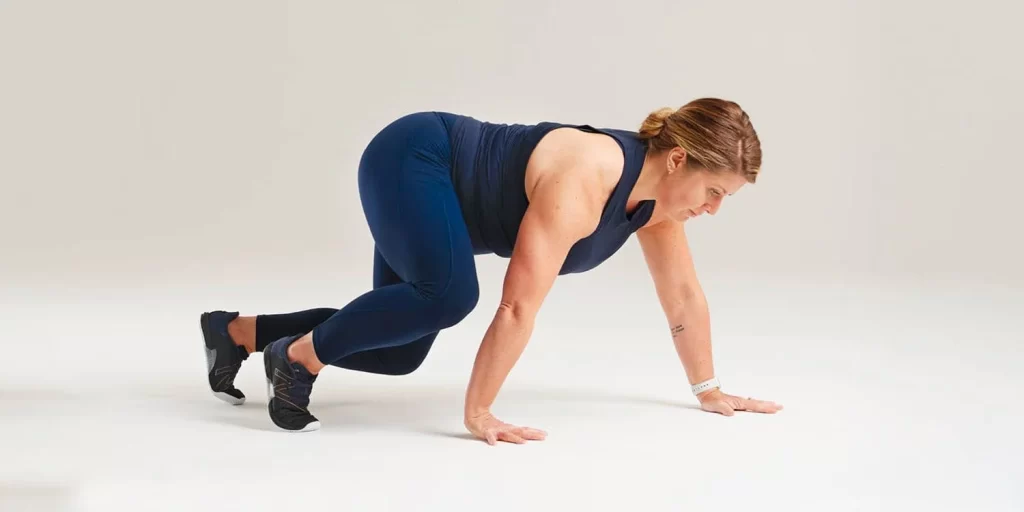
The foot crawl can be started by sitting on a straight chair with both feet on the floor.
Press down on your toes as you try to grip the ground. Now pull all your toes forward as if your legs were crawling. You can do this until you feel comfortable on both feet, but make sure you don’t use your leg muscles to push your feet forward – “crawling” should only be done with your toes. you should repeat this exercise 15-20 times per session, three to five times per day.
Foot-screw

You can sit on the floor for the leg curl exercise. Let the knee go down outward onto the pillow or ball. Now put your foot on the threshold. stabilize the heel together with your hand. Now move your right hand along the threshold of the calf and pull the leg a foot width apart. Now swing your foot slightly forward and spiral down to the resistance of the foot on the inside of your foot. Then bring the leg back to the original position and repeat the screw-like movement several times. Repeat the exercise with the left leg. It has this effect
this exercise is based on the “leg screw” exercise, all the muscle groups that support the foot muscles and provide strength. Repetitions should be 15-20 times per session, do three sets a day
Marble pickup exercise

Don’t let the simplicity of this marble selection exercise fool you. the main purpose of this exercise is it is increase the strength of the foot muscles(this is the one type of strengthening exercise for toes). For the marble pick-up exercise, you have marble around five to ten and arrange the chair and blank mug or bowl. Place ten to fifteen small marbles, stones, or balls on the surface near your feet so they can be picked up by your toes. Place a blank bowel or mug on the floor within your feet’s reach. Try picking up marbles or stones with just your toes.
After picking up the marble on foot keep it in the blank bowl if you are comfortable so you can hold the marble on your toes.
Achilles stretch
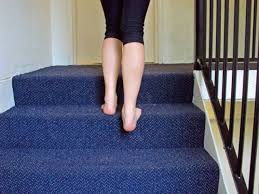
The cord that runs along the heel to the calf muscles is called the Achilles tendon. Flexibility can prevent foot, ankle, and leg pain. The benefit of this exercise is that it increases foot and ankle mobility. Stand facing a wall with your arms outstretched and palms facing the wall. Place one leg behind you, knee straight, and bend the knee of the other leg. Adjust the position so that both heels are flat on the floor. Bend forward from the hips until you feel a stretch in your Achilles tendon and calf muscle.
If necessary, adjust your position to feel the pull by keeping your heels on the floor. If you want to feel the stretch elsewhere, bend the back knee slightly and push your hips forward. Hold the Achilles stretch for around 15-20 seconds and repeat three times per session then switch legs and repeat.
Triangle Stretch
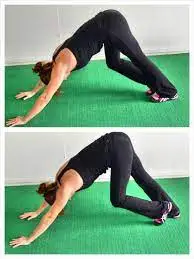
A yoga mat was necessary for Tringle’s stretching. Begin the exercise by placing your hands shoulder-width apart and bending your hips at the same time keep your knees straight to create a triangle shape. you should feel a gentle stretch. Hold the tringle stretch for around 30 seconds. Repetitions should be 15-20 times per session, do three sets a day
Tip toe walking
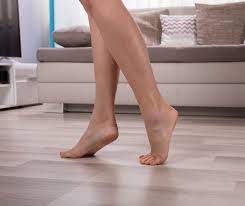
For tip-toe walking arrange the blank room or make a straight line on the ground. follow the straight line by tip-toe walk. The heel and toes should touch. Pick a spot in front of you and focus on keeping yourself steady as you walk. Take a step.
Place the heel right in front of the toe of the other foot. Repeat 20 steps. If you feel unsafe, do this exercise near a wall or have someone nearby help you. the benefits of walking on these toes strengthen the calf muscles and stretch the often shortened extensor muscles.
Foot roll massage
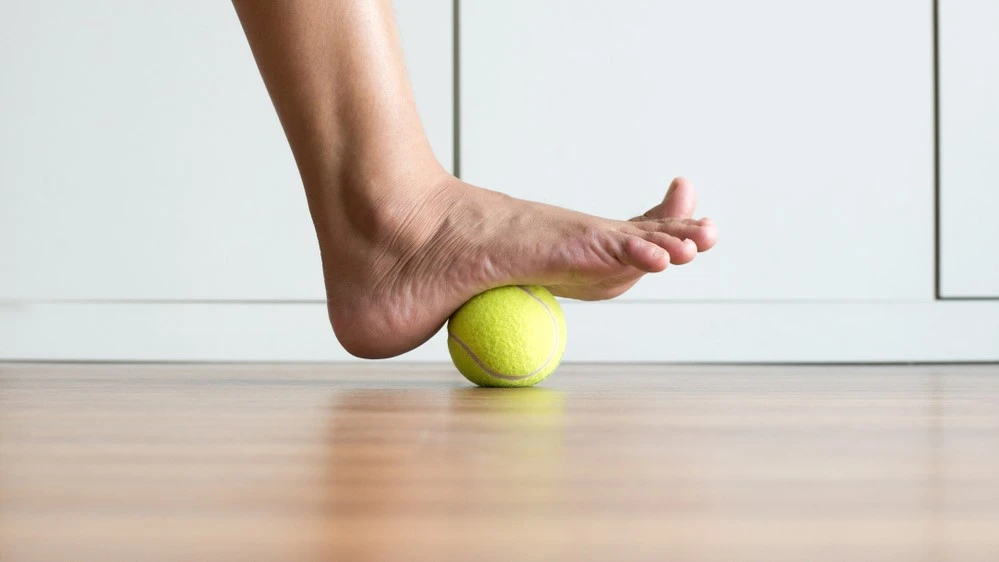
The main benefit of foot roll massage is it provides stretch to your plantar facia. A great way to loosen this tissue while reducing pain and inflammation is to roll a frozen water bottle, lacrosse ball, or tennis ball on the bottom of your foot for 5-10 minutes.
Squeeze a little through the leg into a water bottle or ball – make sure you roll the entire length of the leg. This technique may not be the most comfortable at first, but the relief it provides can be significant.
Although these exercises are easy to do and can help reduce pain, it is important to note that it may take a few weeks to notice significant changes. if you don’t feel pain relief from this massage so you can do this stretch to the other methods. Make an appointment with Performance Therapies to see how we can help you eliminate pain and get back to the things you love.
Sand walking
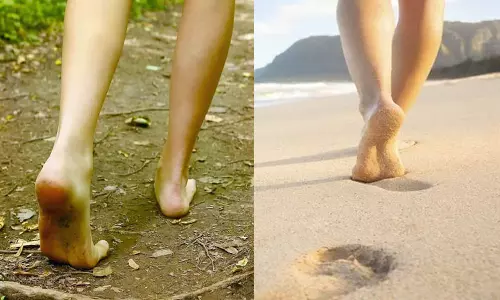
Walking barefoot through the sand strengthens and stretches your feet and toes and provides a great calf workout. Walking on sand is more tiring than walking on hard roads, so be sure to turn around before you tire.
Look for sand at a beach, desert, or volleyball court, for example. Take off your shoes and socks during the walk which is necessary. which is provide better locomotion to your body.
then take a walk for three to five minutes. gradually you can increase the duration of walking. which is added to the progression period.
The Benefit of the toe muscles stretching
Toes are small but important parts of the body. They help you walk, run, stand, and support your entire body weight when you’re on your feet. Being on your feet all day, being a runner or athlete, and wearing tight shoes can cause your toes to:
get out of line
bracket
get sick
lose flexibility
be at greater risk of injury
Some diseases are associated with heavy use of the feet and wearing tight shoes. They include:
spots
hammer finger
Stretching can help your toes change:
retargeted
relaxed
less painful
more flexible
less tired
The main benefit of stretching is that it provides flexibility to tight muscles and also reduces pain… Relaxed and flexible toes are less likely to be injured. Stretching won’t cure pain, hammer toe, or plantar fasciitis, but it can help relieve symptoms and make you feel better.
Prevention for claw toe deformity
Your Physiotherapy or doctors may recommend the following:
Exercise your toes: Extend your toes and pick up small objects with your toes. performed particular toe exercises such as toe extension, toe flexion, toe curls, and toe rotation. stretching of your toe with the help of a resistance band.
Pumice stone: Use a pumice stone to file out grains and calluses.
Wear well-fitting shoes: Choose shoes with a wide and deep toe that is comfortable for the foot and toes. The best shoes if you are prone to bunions have good arch support, short heels, and a very wide toe box.
Practice good foot hygiene: Wash and inspect your feet regularly and keep them dry at all times.
Exercise your legs: Stretch your legs daily to increase flexibility. and do mobility exercises to maintain the range of movement and then you can start the strengthening exercise.
Use special equipment or orthotics: Place arch supports or heel pads in your shoes to prevent the line between the bones of the foot and toe joints from moving abnormally, which reduces the curvature of the toe and provides extra support when walking and standing. Adjust shoelaces or straps to avoid painful pressure points at the top of the toes.
Reduce the use of shoes that cause ingrown toenails: Avoid wearing high-heeled, tight, and pointed-toe shoes, as these can significantly worsen ingrown toenails over time.
General treatment for claw toe deformity
There are both non-surgical and surgical treatments for ingrown toenails. You can do most of the treatment at your home. Non-surgical treatments for ingrown claw toes include:
Orthotic Insoles: Orthotic insoles are designed to fit shoes and provide extra cushioning, and can also be used to stretch and support the toe muscles, helping to correct ingrown toenails. Avoid high heels and narrow shoes. Use shoes with a roomy toe box, low heels, and good arch support. Use cushions, arch supports or other internal parts of the shoe to cushion the toe.
Stretching exercises: Regular stretching exercises can help reduce pain associated with toenails and strengthen the foot and toe muscles needed to correct the deformity. Strengthening and stretching the muscles of the toes with exercises. you can stretch the big and plantar fascia stretch toe regularly.
Splint: A splint is a method that uses braces or a splint to keep the toe in a straighter position while you sleep. This helps reduce stress on the toe muscles during sleep, which can help prevent toe cramps. You can remove the splint during bathing and sleep.
Surgery: If the condition is severe enough, surgery may be the only option to completely repair the nail. During the surgery, the tendons around the toes are released and realigned so that they no longer cause toenails.
The severity of the toenails will determine the type of surgery you will have. Your doctor will classify your toenails as early or late stage, either flexible or rigid. Surgical treatments for ingrown claw toe include:
Tendon lengthening and rerouting.
Shortening of the phalanges.
correct the positioning by temporary insert a steel pin to grasp the toe in the proper or anatomical position until it heals.
Fusion of the toes.
Home Remedies for Claw Toes Deformity
The affected foot should be soaked in warm water with Epsom salt for ten minutes. It helps to relax tense muscles and tendons.
Massage sick toes and feet with medicated oil. This helps reduce pain and improve blood circulation in the area.
Do regular gentle stretching exercises to stretch injured muscles and tendons and reduce toenail fungus.
To reduce pain and inflammation, apply warm foam (hot compress) to the affected area for 5-10 minutes 3-4 times a day. Take herbal supplements like ashwagandha, brahmi, whatever, Guduchi, etc. to help reduce stress levels that can make toenails worse.
A note from Samarpan Physiotherapy Clinic
Take care of your feet by wearing well-fitted footwear, start using of splint at the starting phase of this condition splint provide you with proper anatomical posture which is very important during this condition. Remember that it’s necessary to start treatment as soon as you notice symptoms of claw toes.
If you wait too long, they could become inflexible, and you might need surgery. at the starting phase, you should start the exercise for the flexibility of the toe muscles, and exercise can maintain the mobility of the toe and increase the strength of the foot muscles.
FAQ
Treatment
Wear shoes with soft and wide toes and avoid narrow shoes and heels.
Use your hands to straighten your toes and ankles to a normal position.
Exercise your toes by picking them off marble or crumpling a towel on the ground.
When the flexor digitorum first contracts and overcomes the other muscles of the toe, the middle toe is pulled down, causing the joint between the proximal and middle toe to twist upward. This is known as a toenail.
However, the only way to permanently fix a crooked toe is surgery. This is the only way to restore bones and joints, and when conservative treatments prove insufficient, it may be necessary to relieve pain and restore the enjoyment of daily activities.
Besides looking weird, toes can be painful and difficult to move. You may also have skin infections or calluses where your raised, bent toes rub against your shoes. You may struggle to find shoes that fit comfortably. If your toes are severely damaged, you may find that your balance becomes a problem.
Difference Between Hammertoes vs Claw Toe | Greater … Hammer’s toes curve at the middle joint, forcing the toe down. You can track them on the discs. Toenails usually affect several toes at once and curl around the joint where the toes meet the foot. The toes of the nails are pointed back from the first joint, then flat from the middle joint.

